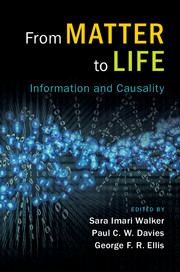Book contents
- Frontmatter
- Contents
- About the authors
- 1 Introduction
- Part I Physics and Life
- Part II Bio from Bit
- 4 (How) Did Information Emerge?
- 5 On the Emerging Codes for Chemical Evolution
- 6 Digital and Analogue Information in Organisms
- 7 From Entropy to Information: Biased Typewriters and the Origin of Life
- Part III Life's Hidden Information
- Part IV Complexity and Causality
- Part V From Matter to Mind
- Index
5 - On the Emerging Codes for Chemical Evolution
from Part II - Bio from Bit
Published online by Cambridge University Press: 02 March 2017
- Frontmatter
- Contents
- About the authors
- 1 Introduction
- Part I Physics and Life
- Part II Bio from Bit
- 4 (How) Did Information Emerge?
- 5 On the Emerging Codes for Chemical Evolution
- 6 Digital and Analogue Information in Organisms
- 7 From Entropy to Information: Biased Typewriters and the Origin of Life
- Part III Life's Hidden Information
- Part IV Complexity and Causality
- Part V From Matter to Mind
- Index
Summary
Life has been described as information flowing in molecular streams (Dawkins, 1996).Our growing understanding of the impact of horizontal gene transfer on evolutionary dynamics reinforces this fluid-like flow of molecular information (Joyce, 2002). The diversity of nucleic acid sequences, those known and yet to be characterized across Earth's varied environments, along with the vast repertoire of catalytic and structural proteins, presents as more of a dynamic molecular river than a tree of life. These informational biopolymers function as a mutualistic union so universal as to have been termed the Central Dogma (Crick, 1958). It is the distinct folding dynamics-the digital-like base pairing dominating nucleic acids, and the environmentally responsive and diverse range of analog-like interactions dictating protein folding (Goodwin et al., 2012)-that provides the basis for the mutualism. The intertwined functioning of these analog and digital forms of information (Goodwin et al., 2012) unified within diverse chemical networks is heralded as the Darwinian threshold of cellular life (Woese, 2002).
The discovery of prion diseases (Chien et al., 2004; Jablonka and Raz, 2009; Paravastu et al., 2008) introduced the paradigm of protein templates that propagate conformational information, suggesting a new context for Darwinian evolution. When taking both protein and nucleic acid moelcular evolution into consideration (Cairns- Smith, 1966; Joyce, 2002), the conceptual framework for chemical evolution can be generalized into three orthogonal dimensions as shown in Figure 5.1 (Goodwin et al., 2014). The 1st dimension manifests structural order through covalent polymerization reactions and includes chain length, sequence, and linkage chemistry inherent to a dynamic chemical network. The 2nd dimension extends the order in dynamic conformational networks through noncovalent interactions of the polymers. This dimension includes intramolecular and intermolecular forces, from macromolecular folding to supramolecular assembly to multicomponent quaternary structure. Folding in this 2nd dimension certainly depends on the primary polymer sequence, and the folding/assembly diversity yields an additional set of environmentally constrained supramolecular folding codes. For example, double-stranded DNA assemblies are dominated by the rules of complementary base pairing, while the self-propagating conformations of prions are based on additional noncovalent, environmentally-dependent interactions.
- Type
- Chapter
- Information
- From Matter to LifeInformation and Causality, pp. 97 - 113Publisher: Cambridge University PressPrint publication year: 2017



